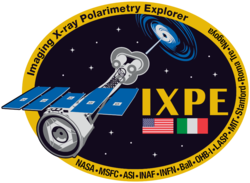 IXPE satellite, on the top are its three identical X-ray optics elements, the sensors are on the bottom. | |
| Names | Explorer 97 IXPE SMEX-14 |
|---|---|
| Mission type | X-ray astronomy satellite |
| Operator | NASA, ASI |
| COSPAR ID | 2021-121A |
| SATCAT no. | 49954 |
| Website | ixpe asi.it/ixpe |
| Mission duration | 5 years (planned) 2 years, 11 months and 14 days (in progress) |
| Spacecraft properties | |
| Spacecraft | Explorer XCVII |
| Spacecraft type | Imaging X-ray Polarimetry Explorer |
| Bus | BCP-100 |
| Manufacturer | Ball Aerospace & Technologies OHB Italia |
| Launch mass | 330 kg (730 lb)[1] |
| Payload mass | 170 kg (370 lb) |
| Dimensions | 1.1 m (3 ft 7 in) in diameter and 5.2 m (17 ft) tall, fully extended Solar array: 2.7 m (8 ft 10 in) fully deployed |
| Start of mission | |
| Launch date | 9 December 2021, 06:00 UTC[3] |
| Rocket | Falcon 9, B1061.5 |
| Launch site | Kennedy Space Center, LC-39A |
| Contractor | SpaceX |
| Entered service | 10 January 2022[2] |
| Orbital parameters | |
| Reference system | Geocentric orbit |
| Regime | Low Earth orbit |
| Perigee altitude | 540 km (340 mi) |
| Apogee altitude | 540 km (340 mi) |
| Inclination | 0.20° |
| Period | 90.00 minutes |
| Main telescope | |
| Type | Three-mirror |
| Focal length | 4 m[4] |
| Wavelengths | X-ray |
| Transponders | |
| Band | S-band[5] |
 IXPE mission logo Explorers Program | |
Imaging X-ray Polarimetry Explorer, commonly known as IXPE or SMEX-14, is a space observatory with three identical telescopes designed to measure the polarization of cosmic X-rays of black holes, neutron stars, and pulsars.[6] The observatory, which was launched on 9 December 2021, is an international collaboration between NASA and the Italian Space Agency (ASI). It is part of NASA's Explorers program, which designs low-cost spacecraft to study heliophysics and astrophysics.
The mission will study exotic astronomical objects and permit mapping of the magnetic fields of black holes, neutron stars, pulsars, supernova remnants, magnetars, quasars, and active galactic nuclei. The high-energy X-ray radiation from these objects' surrounding environment can be polarized – oscillating in a particular direction. Studying the polarization of X-rays reveals the physics of these objects and can provide insights into the high-temperature environments where they are created.[7]
- ^ Cite error: The named reference
eoPortalwas invoked but never defined (see the help page). - ^ "IXPE X-ray observatory completes commissioning, eyes Cassiopeia A for calibration". NASASpaceFlight.com. 10 January 2022. Archived from the original on 11 January 2022. Retrieved 11 January 2022.
- ^ Cite error: The named reference
ixpe-homewas invoked but never defined (see the help page). - ^ Cite error: The named reference
Weisskopf 2016was invoked but never defined (see the help page). - ^ "IXPE Fact Sheet" (PDF). NASA. 2017. Archived (PDF) from the original on 2 April 2019. Retrieved 2 February 2018.
 This article incorporates text from this source, which is in the public domain.
This article incorporates text from this source, which is in the public domain.
- ^ "NASA Selects Mission to Study Black Holes, Cosmic X-ray Mysteries". NASA. 3 January 2017. Archived from the original on 8 December 2021. Retrieved 6 December 2021.
 This article incorporates text from this source, which is in the public domain.
This article incorporates text from this source, which is in the public domain.
- ^ "NASA selects X-ray astronomy mission". SpaceNews. 4 January 2017. Archived from the original on 30 April 2024. Retrieved 9 December 2021.